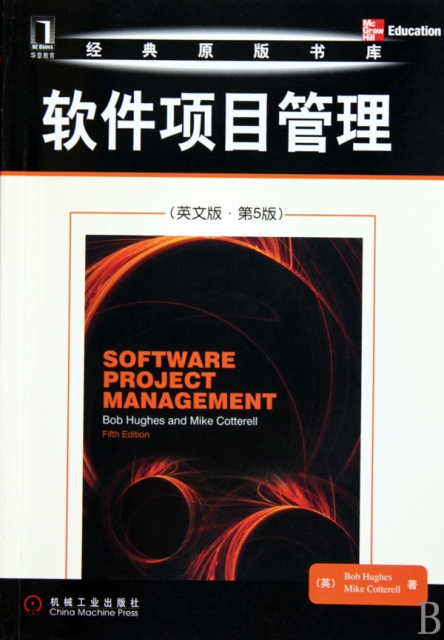| | | | 軟件項目管理(英文版第5版)/經典原版書庫 | | 該商品所屬分類:計算機/網絡 -> 軟件工程 | | 【市場價】 | 353-512元 | | 【優惠價】 | 221-320元 | | 【介質】 | book | | 【ISBN】 | 9787111305378 | | 【折扣說明】 | 一次購物滿999元台幣免運費+贈品
一次購物滿2000元台幣95折+免運費+贈品
一次購物滿3000元台幣92折+免運費+贈品
一次購物滿4000元台幣88折+免運費+贈品
| | 【本期贈品】 | ①優質無紡布環保袋,做工棒!②品牌簽字筆 ③品牌手帕紙巾
|
|
| 版本 | 正版全新電子版PDF檔 | | 您已选择: | 正版全新 | 溫馨提示:如果有多種選項,請先選擇再點擊加入購物車。*. 電子圖書價格是0.69折,例如了得網價格是100元,電子書pdf的價格則是69元。
*. 購買電子書不支持貨到付款,購買時選擇atm或者超商、PayPal付款。付款後1-24小時內通過郵件傳輸給您。
*. 如果收到的電子書不滿意,可以聯絡我們退款。謝謝。 | | | |
| | 內容介紹 | |

-
出版社:機械工業
-
ISBN:9787111305378
-
作者:(英)休斯//考特萊爾
-
頁數:378
-
出版日期:2010-06-01
-
印刷日期:2011-02-28
-
包裝:平裝
-
開本:32開
-
版次:1
-
印次:1
-
本版延續上一版清晰易懂的敘述風格,采用步進式策劃方法逐一分析了軟件開發的各個環節。內容包括項目評價、項目集管理、項目策劃、選擇合適的項目方法、軟件工作量估計、活動策劃、風險管理、資源分配、監督和控制、管理合同、人員管理、團隊管理和軟件質量等。
-
本書是經典的項目管理課程教材。本版延續上一版清晰、易懂的敘述
風格,采用步進式策劃方法逐一分析了軟件開發的各個環節,並通過豐富
的實例和練習來闡明實踐過程中軟件項目管理的原則。
本書不僅適合作為計算機及相關專業的本科生和研究生的教材,而且
適合於軟件項目管理人員和軟件開發人員閱讀,還特別適合作為BCS/ISEB
專業考試的參考書。
為了涵蓋軟件項目管理的新進展,本版進行了全面更新,新增和擴展
的主題如下:
溝通策劃。
敏捷方法,包括XP(極限編程)、Scrum 和 DSDM。
COCOMO Ⅱ。
項目組合管理。
新增一章,主要是關於合作、分散和虛擬團隊管理。
職業道德規範。
-
Preface
Guided tour
Acknowledgements
I Introduction to software project management
1.1 Introduction
1.2 Why is software project management important?
1.3 What is a project?
1.4 Software projects versus other types of project
1.5 Contract management and technical project management
1.6 Activities covered by software project management
1.7 Plans, methods and methodologies
1.8 Some ways of categorizing software projects
1.9 Stakeholders
1.10 Setting objectives
1.11 The business case
1.12 Project success and failure
1.13 What is management?
1.14 Management control
1.15 Conclusion
Annex 1 Contents list for a project plan
1.16 Further exercises
2 Project evaluation and programme management
2.1 Introduction
2.2 A business case
2.3 Project portfolio management
2.4 Evaluation of individual projects
2.5 Cost-benefit evaluation techniques
2.6 Risk evaluation
2.7 Programme management
5.8 Managing the allocation of resources within programmes
2.9 Strategic programme management
2.10 Creating a programme
2.11 Aids to programme management
2.12 Some reservations about programme management
2.13 Benefits management
2.14 Conclusion
2.15 Further exercises
3 An overview of project planning
3.1 Introduction to Step Wise project planning
3.2 Step O: Select project
3.3 Step 1: Identify project scope and objectives
3.4 Step 2: Identify project infrastructure
3.5 Step 3: Analyse projec characteristics
3.6 Step 4: Identify project products and activities
3.7 Step 5: Estimate effort for each activity
3.8 Step 6: Identify activity risks
3.9 Step 7: Allocate resources
3.10 Step 8: Review/publicize plan
3.11 Steps 9 and10: Execute plan/lower levels of planning
3.12 Conclusion
3.13 Further exercises
4 Selection of an appropriate project approach
4.1 Introduction
4.2 Build or buy?
4.3 Choosing methodologies and technologies
4.4 Choice of process models
4.5 Structure versus speed of delivery
4.6 The waterfall model
4.7 The spiral model
4.8 Software prototyping
4.9 Other ways of categorizing prototypes
4.10 Incremental delivery
4.11 Agile methods
4.12 Atern/Dynamic Systems Development Method
4.13 Extreme programming (XP)
4.14 Managing iterative processes
4.15 Selecting the most appropriate process model
4.16 Conclusion
4.17 Further exercises
5 Software effort estimation
5.1 Introduction
5.2 Where are estimates done?
5.3 Problems with over- and under- estimates
5.4 The basis for software estimating
5.5 Software effort estimation techniques
5.6 Bottom-up estimating
5.7 The top-down approach and parametric models
5.8 Expert judgement
5.9 Estimating by analogy
5.10 Albrecht function point analysis
5.11 Function points Mark Il
5.12 COSMIC full function points
5.13 COCOMO 13: a parametric productivity model
5.14 Conclusion
5.1 5 Further exercises
6 Activity planning
6.1 Introduction
6.2 The objectives of activity planning
6.3 When to plan
6.4 Project schedules
6.5 Projects and activities
6.6 Sequencing and scheduling activities
6.7 Network planning models
6.8 Formulating a network model
6.9 Adding the time dimension
6.10 The forward pass
6.11 The backward pass
6.12 Identifying the critical path
6.1 3 Activity float
6.14 Shortening the project duration
6.1 5 Identifying critical activities
6.16 Activity-on-arrow networks
6.1 7 Conclusion
6.16 Further exercises
7 Risk management
7.1 Introduction
7.2 Risk
7.3 Categories of risk
7.4 A framework for dealing with risk
7.5 Risk identification
7.6 Risk assessment
7.7 Risk planning
7.8 Risk management
7.9 Evaluating risks to the schedule
7.10 Applying the PERT technique
7.11 Monte Carlo simulation
7.1 2 Critical chain concepts
7.1 3 Conclusion
7.14 Further exercises
8 Resource allocation
8.1 Introduction
8.2 The nature of resources
8.3 Identifying resource requirements
8.4 Scheduling resources
8.5 Creating critical paths
8.6 Counting the cost
8.7 Being specific
8.8 Publishing the resource schedule
8.9 Cost schedules
8.10 The scheduling sequence
8.11 Conclusion
8.12 Further exercises
9 Monitoring and control
9.1 Introduction
9.2 Creating the framework
9.3 Collecting the data
9.4 Visualizing progress
9.5 Cost monitoring
9.6 Earned value analysis
9.7 Prioritizing monitoring
9.8 Getting the project back to target
9.9 Change control
9.10 Conclusion
9.11 Further exercises
10 Managing contracts
10.1 Introduction
10.2 Types of contract
10.3 Stages in contract placement
10.4 Typical terms of a contract
10.5 Contract management
10.6 Acceptance
10.7 Conclusion
10.8 Further exercises
11 Managing people in software environments
11.1 Introduction
11.2 Understanding behaviour
11.3 Organizationbehaviour: a backgrou nd
11.4 Selecting the right person for the job
11.5 Instruction in the best methods
11.6 Motivation
11.7 TheOIdham Hackman job characteristics nrodel
11.8 Stress
11.9 Health and safety
11.10 Some ethical and professional concerns
11.11 Conclusion
11.12 Further exercises
12 Working in teams
12.1 Introduction
12.2 Becoming a team
12.3 Decision making
12.4 Organizational structures
12.5 Coordination dependencies
12.6 Dispersed and virtual teams
12.7 Communication genres
12.8 CommunicationpJans
12.9 Leadership
12.10 Conclusion
12.11 Further exercises
13 Software quality
13.1 hrtroduc'tion
13.2 iheplaceofsoftwarequalityin project planning
13.3 The importance of software quality
13.4 Defining software quality
13.5 ISO 9126
13.6 Product versus process quality management
13.7 Quality management systems
13.8 Process capability models
13.9 Techniques to help enhance software quality
13.10 resting
13.11 Quality plans
13.12 Conclusion
13.13 Further exercises
Appendix A PRINCE2 - an overview
Appendix B Answer pointers
Further reading
Index
| | |
| | | | |
|




